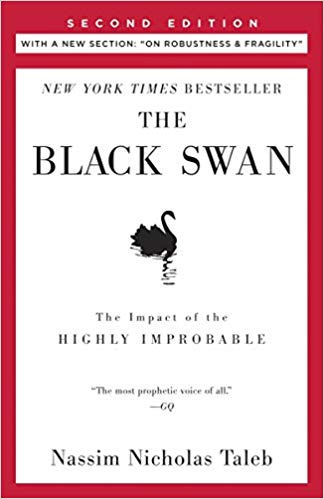

This article is an excerpt from the Shortform summary of "The Black Swan" by Nassim Taleb. Shortform has the world's best summaries of books you should be reading.
Like this article? Sign up for a free trial here .
Accurate predictions are hard to make. The world is full of uncertainty. How do you make plans when you can’t know the future? How do you deal with uncertainty?
We’ll cover the difficulties with making accurate predictions and how to deal with uncertainty in an unpredictable world.
Difficulties of Prediction
Before we explore how to deal with uncertainty, let’s look at why there’s so much uncertainty in the first place. The central problem with experts is their uncritical belief in the possibility of prediction, despite the mountain of evidence that indicates prediction is a fool’s errand. Some key illustrations of the futility of prediction include:
Discoveries
Most groundbreaking discoveries occur by happenstance—luck—rather than careful and painstaking work. The quintessential example is the discovery of penicillin. Discoverer Alexander Fleming wasn’t researching antibiotics; rather, he was studying the properties of a particular bacterium. He left a stack of cultures lying out in his laboratory while he went on vacation, and when he returned he found that a bacteria-killing mold had formed on one of the cultures. Voilá—the world’s first antibiotic. Randomness is one reason we’re forced into dealing with uncertainty.
Dynamical Systems
A dynamical system is one in which an array of inputs affect each other. Whereas prediction in a system that contains, say, two inputs, is a simple affair—one need only account for the qualities and behavior of those two inputs—prediction in a system that contains, say, five hundred billion inputs is effectively impossible.
The most famous illustration of a dynamical system’s properties is the “butterfly effect.” This idea was proposed by an MIT meteorologist, who discovered that an infinitesimal change in input parameters can drastically change weather models. The “butterfly effect” describes the possibility that the flutter of a butterfly’s wings can, a few weeks later and many miles distant, cause a tornado. Dynamical systems is another reason we find ourselves dealing with uncertainty.
Predicting the Past
The past itself is as unknowable as the future. Because of how complex the world is and how a single event could be influenced by any number of tiny causes, we cannot reverse engineer causes for events.
An example should help illustrate. Think of an ice cube sitting on a table. Imagine the shape of the puddle that ice cube will make as it melts.
Now think of a puddle on the table and try to imagine how that puddle got there.
When historians propose causes for certain historical events, they’re looking at puddles and imagining ice cubes (or a spilled glass of water, or some other cause). The problem is that the sheer number of possible causes for a puddle—or a historical event—render any ascription of cause suspect. The past isn’t explainable, and the future isn’t predictable, so we have to deal with uncertainty.
Dealing with Uncertainty
How do we handle uncertainty? Although Taleb is far more concerned with explaining why prediction is impossible than he is with proposing alternatives or solutions, he does offer some strategies for dealing with uncertainty.
1) Don’t Sweat the Small Predictions
When it comes to low-stakes, everyday predictions—about the weather, say, or the outcome of a baseball game—there’s no harm in indulging our natural penchant for prediction: If we’re wrong, the repercussions are minimal. It’s when we make large-scale predictions and incur real risk on their basis that we get into trouble. This is one way of dealing with uncertainty.
2) Maximize Possibilities for Positive Black Swans
Although the most memorable Black Swans are typically the negatively disruptive ones, Black Swans can also be serendipitous. (Shortform note: Love at first sight is an example of a serendipitous Black Swan.)
Two strategies for opening ourselves up to positive Black Swans are (1) sociability and (2) proactiveness when presented with an opportunity. Sociability puts us in the company of others who may be in a position to help us—we never know where a casual conversation might lead. And proactiveness—for example, taking up a successful acquaintance on an invitation to have coffee—ensures we’ll never miss our lucky break. This is another way of dealing with uncertainty.
3) Adopt the “Barbell Strategy”
A third way of dealing with uncertainty is to adopt the barbell strategy. When Taleb was a trader, he pursued an idiosyncratic investment strategy to inoculate himself against a financial Black Swan. He devoted 85%–90% of his portfolio to extremely safe instruments (Treasury bills, for example) and made extremely risky bets—in venture-capital portfolios, for example—with the remaining 10%–15%. (Another variation on the strategy is to have a highly speculative portfolio but to insure yourself against losses greater than 15%.) The high-risk portion of Taleb’s portfolio was highly diversified: He wanted to place as many small bets as possible to increase the odds of a Black Swan paying off in his favor.
The “barbell strategy” is designed to minimize the pain of a negative Black Swan while, potentially, reaping a positive Black Swan’s benefits. If the market collapses, a person pursuing this strategy isn’t hurt beneath the “floor” of the safe investments (say, 85%), but if the market explodes, he has a chance to capitalize by virtue of the speculative bets.
4) Distinguish Between Positive Contingencies and Negative Ones
Different areas of society have different exposure to Black Swans, both positive and negative. For example, scientific research and moviemaking are “positive Black Swan areas”—catastrophes are rare, and there is always the possibility of smashing success. The stock market or catastrophe insurance, meanwhile, are “negative Black Swan areas”—upsides are relatively modest compared to the possibility of financial ruin.
Suffice it to say, we should take more risks in a positive Black Swan area than in a negative Black Swan one. This is another way of dealing with uncertainty.
5) Prepare, Don’t Predict
Because Black Swans are, by definition, unpredictable, we’re better off preparing for the widest range of contingencies than predicting specific events.
That’s because, though Black Swans themselves can never be predicted, their effects can be. For example, no one can predict when an earthquake will strike, but one can know what its effects will be and prepare adequately to handle them.
The same goes for an economic recession. No one can predict precisely when one will occur, but, using the “barbell strategy” or some other means of mitigating risk, we can at least be prepared for one. Preparing may be the best way to deal with uncertainty.
———End of Preview———

Like what you just read? Read the rest of the world's best summary of "Black Swan" at Shortform . Learn the book's critical concepts in 20 minutes or less .
Here's what you'll find in our full Black Swan summary :
- Why world-changing events are unpredictable, and how to deal with them
- Why you can't trust experts, especially the confident ones
- The best investment strategy to take advantage of black swants






